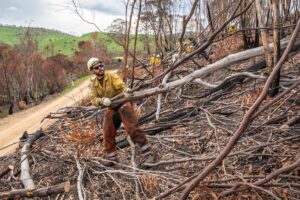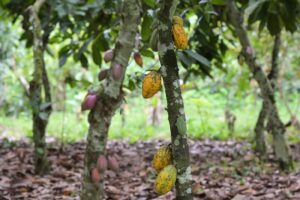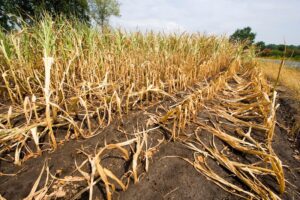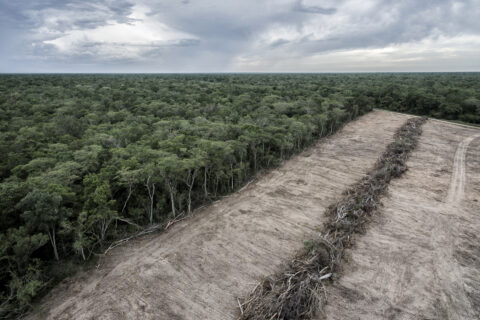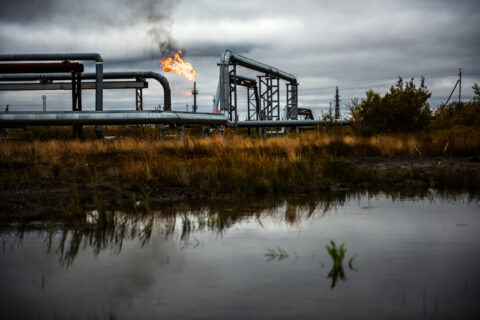Even passing 1.5C of global warming temporarily would trigger a “significant” risk of Amazon forest “dieback”, says a new study.
Dieback would see large numbers of trees die, shifting the lush rainforest into a dry savannah.
The research, published in Nature Climate Change, assesses the impact of “overshooting” the aspirational goal of the Paris Agreement on the Amazon and Siberian forests.
Overshoot would see warming surpass 1.5C above pre-industrial levels in the coming decades, before being brought back down before 2100 through large-scale carbon dioxide removal.
Using hundreds of climate-model simulations, the authors assess the influence of the “sensitivity” of the climate – a measure of the planet’s temperature response to a given increase in atmospheric CO2.
Across all simulations where global warming in 2100 surpasses 1.5C, 37% show “some amount of dieback”, the study says.
However, the risk increases further in the long term, with “55% of simulations exhibiting dieback by 2300”.
One author tells Carbon Brief that the study highlights that overshooting 1.5C leaves forest ecosystems “exposed to more risk than [they] need to be”.
The findings show that “we can’t afford complacency”, he warns.
Warming pathways
As the planet warms, there is an increasing risk that parts of the Earth system will cross “tipping points” – critical thresholds that, if exceeded, could push a system into an entirely new state.
For example, a seminal 2022 study warned that five tipping elements – including the collapse of the West Antarctic ice sheet and abrupt permafrost thaw – are already within reach, while others are becoming increasingly more likely as temperatures rise.
One way to limit warming to 1.5C by the end of the century involves initially overshooting the threshold. However, research published last year warns that the longer the 1.5C threshold is breached – and the higher the peak temperature – the greater the risk of crossing tipping points.
The new study uses modelling to investigate the risks of overshoot for the Amazon and Siberian forests.
The paper considers three illustrative mitigation pathways taken from the Intergovernmental Panel on Climate Change’s (IPCC) mitigation report from its sixth assessment cycle, which was published in 2022.
Gregory Munday is an applied scientist at the UK Met Office Hadley Centre and lead author on the study. He tells Carbon brief that the authors selected “optimistic” pathways that “each have different relationships to the Paris Agreement goals”.
For each scenario, the authors assess a range of different climate sensitivities – a measure of the planet’s temperature response to a given increase in atmospheric CO2. The average outcome of each pathway is:
- The “renewables” scenario shows a future with reduced emissions and a heavy reliance on renewable energy, which keeps warming below 1.5C by 2100.
- The “negative emissions” pathway shows a world in which warming initially overshoots the 1.5C threshold, but extensive use of carbon removal sees warming drop back below 1.5C before 2100.
- The “gradual strengthening” pathway illustrates a strengthening of climate policies implemented in 2020, with rapid reductions mid-century and a reliance on net-negative emissions by the end of this century. This pathway sees global average temperatures reach 1.8C by 2100.
The authors run the emissions pathways through a simple climate “emulator” model, which calculates the global temperatures associated with each emission pathway.
The charts below show cumulative CO2 emissions (left), atmospheric CO2 concentration (middle) and changes in global average surface temperature compared to the pre-industrial level (right), for the renewables (green), negative emissions (purple) and gradual strengthening (yellow) pathways until the year 2300.

The authors then use a different modelling framework to project the impacts of each emissions scenario.
Study author Dr Chris Jones leads the UK Met Office Hadley Centre’s research into vegetation and carbon cycle modelling and their interactions with climate. He tells Carbon Brief that the new study is the first application of this modelling framework, which he describes as a “rapid response tool”.
He says the tool was developed to “rapidly look at a range of climate outcomes, both global and local, for new scenarios”, adding that it provides a “pretty good approximation” of what traditional global climate models would do.
Munday adds that the framework is able to produce results within days or weeks, rather than taking “months and months”.
Finally, the authors use land surface model JULES to assess forest health under the different scenarios. Overall, the authors produce 918 simulations each of Amazon and Siberian forest health.
Forest health
The authors assess forest health using two metrics. The first is the forest growth metric “net primary productivity”, a measure of the rate that energy is stored as biomass by plants, which can indicate forest productivity. The second metric, forest cover, is a way of measuring the forest’s long-term response.
The models show that rising CO2 levels causes net primary productivity to increase, due to the CO2 fertilisation effect, driving more rapid forest growth. Conversely, many of the impacts of climate change, such as increased heat and changes to rainfall patterns, can be detrimental to forests, damaging or killing trees.
To identify the impacts of overshooting 1.5C on the Amazon and Siberian forests, the authors compare the “renewables” and “negative emissions” pathways. Both of these scenarios reach a similar global average temperature by the year 2100, but the former does so without overshoot, while the latter overshoots 1.5C before temperatures come back down.
The maps below show the difference in net primary productivity in the Amazon (left) and Siberian forests (right) between the two scenarios in the year 2100. Brown shading indicates that net primary productivity was higher in the non-overshoot scenario, while blue indicates that it was higher in the overshoot scenario.

The maps show that “large areas of both Amazonian and Siberian forest show reduced net primary productivity” by 2100 due to overshoot, compared to a scenario with no overshoot, the paper says.
‘High-risk zones’
From the three pathways, the authors generate 918 simulations of future climate and corresponding Amazon forest health.
The authors use these results to identify which future temperature and rainfall conditions result in net forest “dieback”. This is when large numbers of trees die, shifting the rainforest into a dry savannah.
The plots below show which simulations result in Amazon dieback by the year 2100 (left) and 2300 (right), for different amounts of rainfall and temperature levels in the year 2100. Each graph is divided into four sections – hot and wet (top right), hot and dry (bottom right), cold and wet (top right) and cold and dry (bottom right). These sections are based on average regional temperature and rainfall in the year 2100.
Coloured dots indicate scenarios that see forest dieback. These are coloured by pathway, for renewables (green), negative emissions (purple) and gradual strengthening (yellow). Grey dots indicate scenarios without Amazon dieback. The red lines indicate “high-risk climatic zones”, above which there is “a significant risk of dieback”.
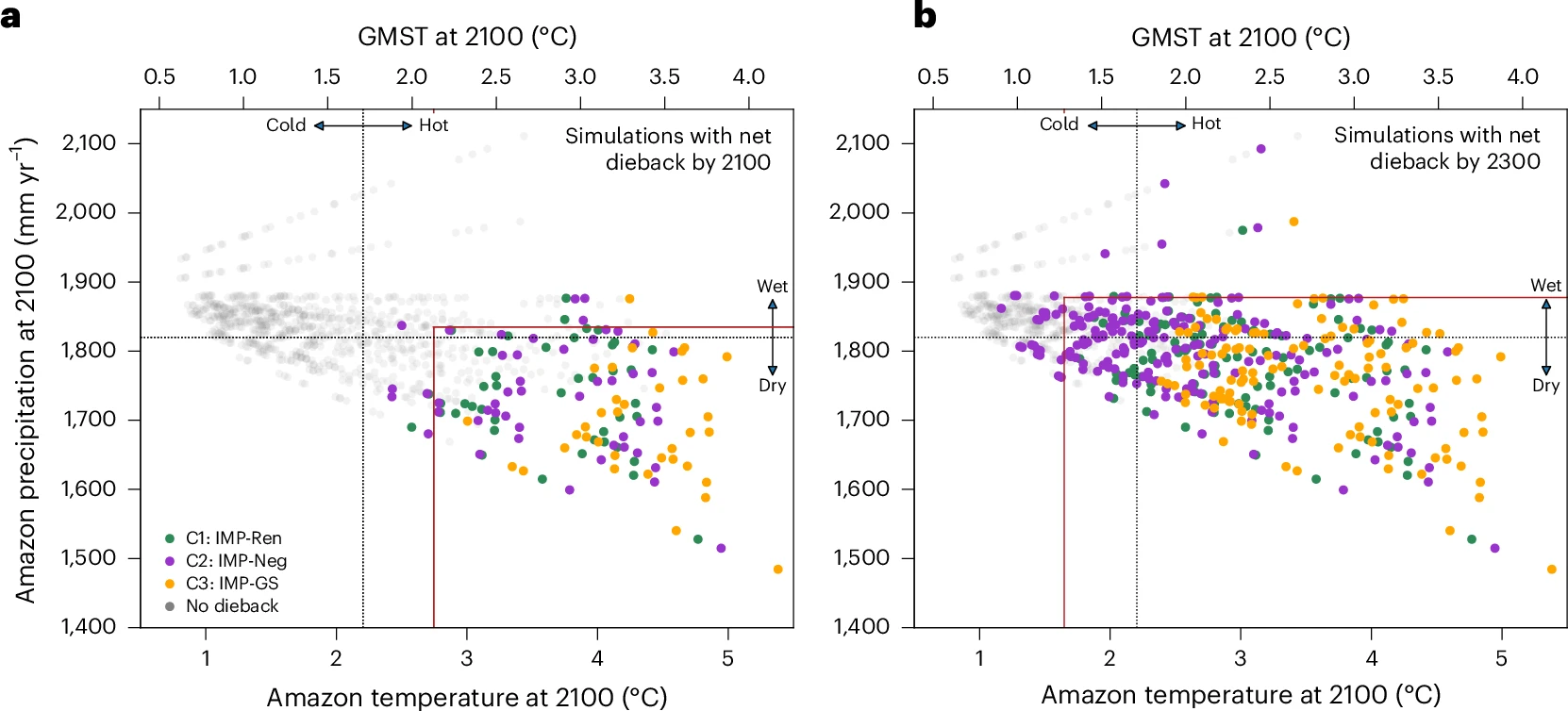
The study finds that most Amazon dieback scenarios happen in hot, dry conditions, the authors note.
Across all simulations where warming in 2100 is above 1.5C, 37% show “some amount of dieback” the study says. However, in these model runs, the risk increases further in the long term, the study notes, with “55% of simulations exhibiting dieback by 2300”.
Prof Nico Wunderling is a professor of computational Earth system science at the Potsdam Institute for Climate Impact Research and was not involved in the new research. He tells Carbon Brief it is significant that, according to this study, the Amazon will face impacts from climate change below the tipping point threshold of 2-6C, as assessed in the landmark 2022 tipping points paper.
The authors also carry out this analysis for Siberian forests. Instead of a drop in tree cover, they find a change in the composition of trees. Munday tells Carbon Brief that the vegetation shifts “from grassy surface types to lots more trees and shrubs” in a process called “woody encroachment”.
Woody encroachment can have significant negative impacts on terrestrial carbon sequestration, the hydrological cycle and local biodiversity.
“The Siberian forest is probably committed to a long-term, and possibly substantial, expansion of tree cover,” the authors write.
High-risk scenarios
The greatest uncertainty in this study comes from the spread of climate sensitivities, Munday tells Carbon Brief.
He elaborates:
“This means that although we simulate the impacts from extremely optimistic mitigation scenarios, there is a chance that the Earth’s climate sensitivity is much higher than we expect, and so, small but significant risks of short- and long-term forest ecosystem impacts exist in spite of the choice of these strong-mitigation scenarios.”
In other words, if climate sensitivity is higher than expected, forests could face harmful impacts even under low emissions scenarios.
Dr David McKay – a lecturer in geography, climate change and society at the University of Sussex – is the lead author of the 2022 study. He tells Carbon Brief that the new paper “shows the value in focusing not just on model averages, but also exploring a wide range of possible futures to capture potential ‘low probability, high impact’ outcomes”. He adds:
“[The study shows] how negative emissions to reduce warming might help restabilise these forests in future if we do overshoot 1.5C, but as such large-scale CO2 removal remains hypothetical, we shouldn’t assume we can rely on this in practice.”
However, McKay also notes some uncertainties in the models used. Mckay tells Carbon Brief that the vegetation model used in this study doesn’t include fire and “has some limitations around soil moisture stress and vegetation in the tundra”. These are “likely important for resolving potential tipping points in these biomes”.
Therefore, he adds, the study “doesn’t show how regional tipping points could potentially further amplify and lock-in these future forest shifts, even with negative emissions”.
Dr David Lapola is researcher at the University of Campinas in Brazil and was not involved in the study. He also warns that vegetation models provide a “poor representation of how CO2 may affect these forests directly”. Lapola argues that scientists must “collect field data to make any new advancement with models”.
Nevertheless, Lapola tells Carbon Brief that studies such as this will be “extremely useful” for the IPCC’s upcoming seventh assessment cycle, which will include a dedicated chapter on tipping points and other “low-likelihood high impact events” for the first time.
Study author Jones tells Carbon Brief that overshooting 1.5C leaves forest ecosystems “exposed to more risk than [they] need to be”. The findings show that “we can’t afford complacency”, he warns.
The post ‘Significant’ risk of Amazon forest dieback if global warming overshoots 1.5C appeared first on Carbon Brief.
‘Significant’ risk of Amazon forest dieback if global warming overshoots 1.5C
Climate Change
EAT-Lancet report: Three key takeaways on climate and diet change
A global shift towards “healthier” diets could cut non-CO2 greenhouse gas emissions, such as methane, from agriculture by 15% by 2050, according to a new report.
The EAT-Lancet Commission report on “healthy, sustainable and just food systems” says this diet would require producing more fruit, vegetables and nuts, as well as fewer livestock.
The findings build on the widely cited 2019 report from the EAT-Lancet Commission – a group of leading experts in nutrition, climate, economics, health, social sciences and agriculture from around the world.
The new report notes that one-third of all greenhouse gas emissions come from the global food system.
These emissions are so great that, even if all fossil fuels were phased out, “food can on its own push us beyond the 1.5C limit”, one of the commission co-chairs, Prof Johan Rockström, told a press briefing.
The report details a “planetary health diet” – a concept first introduced in the 2019 report – which focuses on “plant-rich” and “minimally processed” foods.
The latest edition builds on the previous report by adding improved modelling of food-system transformation and adding social-justice considerations.
The 2019 report faced a “massive online backlash” against some of its findings, particularly on cutting meat consumption, DeSmog reported earlier this year, which was “stoked by a PR firm that represents the meat and dairy sector”.
Rockström said the commission is “ready to meet that assault” if it arises again and issued concern “over this return of mis- and disinformation and denialism on climate science”.
Here, Carbon Brief picks out three key takeaways from the latest report.
- A ‘plant-rich’ diet has the best health and climate outcomes
- Transforming food systems could ‘substantially reduce’ the associated emissions
- Social justice should be a ‘central goal’ in transforming global food systems
A ‘plant-rich’ diet has the best health and climate outcomes
The new report recommends a plant-rich “planetary health diet”, which is largely the same as the one first outlined in the 2019 report.
The diet is designed to be flexible and “compatible with many foods, cultures, dietary patterns, traditions and individual preferences”, the report says.
It does not exclude meat or dairy products – the foods that cause the highest emissions – but recommends limited portions, equating to around one glass of milk per day and a couple of servings of meat and two eggs each week, for those whose diets include them.
The chart below outlines the recommended intake of different foods, adding up to around 2,400 calories each day. A range is given for each food type to accommodate different diets. The categories with the largest intakes include whole grains, plant oils, nuts and legumes.

The diet is “designed for health…[not] sustainability”, Dr Line Gordon, a commissioner on the report, told a press briefing.
But the report also analyses the climate impact of the recommendations. It estimates that shifting to the planetary diet could reduce global non-CO2 agricultural emissions – from greenhouse gases such as methane and nitrous oxide – by 15% by 2050. (See: Transforming food systems could ‘substantially reduce’ the associated emissions.)
Widespread adoption of the diet would require a two-thirds increase in fruit, vegetable and nut production and allow for a one-third reduction in livestock meat production, compared to 2020 levels.
Currently, diets across the globe all “deviate substantially” from the report’s recommendations. But the report claims that, due to the planetary diet’s health benefits, around 15 million “avoidable” deaths could be prevented each year if it were widely adopted.
The report also measures how much global food systems contribute to the nine planetary boundaries – a concept of global thresholds for a “safe and just” planet. It finds that food systems are the largest contributor to five breaches of these boundaries, which include changes in the use of land and freshwater.
In terms of steps to move towards the planetary diet, Gordon listed actions such as changing taxes to make healthy foods more affordable, clearly labelling foods and shifting agricultural production subsidies towards healthier foods.
The report highlights that “transforming food systems is not only possible, it’s essential to securing a safe, just and sustainable future for all”, Rockström says in a statement.
Transforming food systems could ‘substantially reduce’ the associated emissions
Food systems are responsible for about one-third of human-driven greenhouse gas emissions.
These emissions are roughly equally partitioned between livestock and crop production, land-use change and other aspects of the food system, including refrigeration, fertilisers, transport and retail, according to the report.
The authors use global economic models to determine how different actions towards transforming food systems could affect agricultural production, environmental impact and food prices.
For the baseline, they use a set of “business-as-usual” parameters. This scenario uses SSP2-7.0, a high-emissions pathway under which there is a global population of 9.6 billion people and global warming of 2C above pre-industrial temperatures in 2050.
Using these assumptions, the business-as-usual scenario results in a 37% increase in global agricultural production and a 33% rise in non-CO2 agricultural emissions by 2050, compared to 2020. Crop yields increase by nearly one-quarter in this scenario, while the amount of land used for agricultural cultivation expands by 2m square kilometres (km2) – an area roughly the size of Mexico.
The chart below shows the changes in non-CO2 agricultural emissions and agricultural land use under each scenario, with the three main scenarios highlighted in green. The dots indicate the results from different model runs.

The dietary transformation projection assumes a world in which there is total adherence to the suggested diet, a halving of food loss and waste and an additional 7-10% increase in global agricultural productivity.
They find that, in this scenario, agricultural emissions of non-CO2 greenhouse gases decline by 20% compared to 2020 values. Although cropland will have to expand to account for the increased intake of fruits, vegetables and legumes, the decrease in land needed for livestock-rearing means that agricultural land use will fall overall by 3.4m km2, an area the size of India.
The authors also consider a scenario that combines the dietary shifts with “ambitious mitigation” efforts. This includes policies such as carbon pricing and land-use regulations that could drive the adoption of bioenergy, afforestation and renewable energy, the report says.
Under widespread dietary shifts and ambitious mitigation, the report finds that non-CO2 emissions from agriculture will fall by 34% compared to 2020, and the reduction in agricultural land use will double compared to the scenario that only factors in the dietary shifts.
Social justice should be a ‘central goal’ in transforming global food systems
In a step further than its predecessor, the new report assesses justice in global food systems, by analysing the rights to food, a healthy environment and decent work.
The focus on social equity and justice added a “tremendous broader aspect” to the report, Dr Shakuntala Thilsted, one of the commission co-chairs, said in a briefing.
The report notes that more than half of the world’s population struggles to access healthy diets, which leads to “devastating consequences for public health, social equity and the environment”.
This primarily affects marginalised people living in low-income regions, it says.
The report finds that the diets of the world’s richest 30% of the population contribute to more than 70% of environmental pressures from food systems, such as land use and greenhouse gas emissions. The report says:
“These statistics highlight the large inequalities in the distribution of both benefits and burdens of current food systems.”
Furthermore, living and working in toxic-free environments and stable climate conditions is a “crucial” human right, it adds.
According to the report, “power asymmetries and discriminatory social and political structures” – such as the concentration of power among a small number of agribusiness firms – hinder the fulfilment of those rights.
The report says that social justice, along with environmental sustainability, should be central to global food systems.
It proposes several steps to making healthy, sustainable and just food systems more accessible by 2050: securing decent working conditions, ensuring liveable wages, recognising and protecting marginalised groups and limiting market concentration.

It notes that while taking steps to mitigate climate change will increase food costs – particularly in areas that currently do not consume adequate fruits and vegetables, and where animal-sourced food is less commonly eaten – some of these pressures can be alleviated by introducing subsidies targeted towards those preferred food groups.
Finally, the authors underscore that implementing this diet must consider both cultural context and sustainability.
However, they also warn that meeting these goals requires global action and “transformative change” in both individual and cultural habits.
The post EAT-Lancet report: Three key takeaways on climate and diet change appeared first on Carbon Brief.
EAT-Lancet report: Three key takeaways on climate and diet change
Climate Change
China Briefing 2 October 2025: China’s new pledge; electricity demand slows; steel overcapacity
Welcome to Carbon Brief’s China Briefing.
China Briefing handpicks and explains the most important climate and energy stories from China over the past fortnight. Subscribe for free here.
Key developments
China’s first-ever pledge to cut emissions
NEW CLIMATE TARGETS: In a video address to the UN last week, China’s president Xi Jinping personally pledged to cut his nation’s economy-wide greenhouse gas emissions to 7-10% below peak levels by 2035, while “striving to do better”, reported state broadcaster CCTV. Sky News called it a “landmark moment”, saying that this marked the first time China “made a commitment to cut its greenhouse gas emissions”. The announced target, along with other commitments such as expanding wind and solar power capacity to more than six times 2020 levels, will be included in China’s 2035 “nationally determined contribution” (NDC) under the Paris Agreement, which has not yet been submitted, reported BBC News. Carbon Brief published a detailed analysis of the announcement and hosted a webinar with climate policy experts to discuss their assessments. More details of the webinar can be found below.

AMBITION CRITICISM: In an article for Just Security, Sue Biniaz, former US principal deputy special envoy for climate, wrote that “at and around the UN event, the chatter regarding the announcement was generally negative”, adding that the announced target was “even lower than expected”. EU climate chief Wopke Hoekstra described China’s new climate pledge as falling “well short of what we believe is both achievable and necessary”, reported Reuters. In response, China accused the EU of “being slow to act on its own climate targets”, according to another Reuters report. The outlet said that Hoekstra’s “criticism of China’s new climate pledges shows ‘double standards and selective blindness’, China’s foreign ministry said on Friday”.
-
Sign up to Carbon Brief’s free “China Briefing” email newsletter. All you need to know about the latest developments relating to China and climate change. Sent to your inbox every Thursday.
MEDIA REACTION: Media outlets including the Guardian and the Times raised questions about the ambition of the target. Similarly, Bloomberg said it was “seen as too modest to put the nation on a path to net-zero and galvanise global climate action”. An editorial in state-run newspaper China Daily, however, called the target a “milestone in the nation’s long-term road map toward green, low-carbon development”. Li Shuo, director of the China Climate Hub at the Asia Society Policy Institute, wrote in a comment for the New York Times that China’s targets “may seem tepid”, but “beneath them is a bold wager: that steady action, powered by industrial strength and vision shielded from political volatility, will ultimately do more to contribute to the global climate effort than lofty, fickle promises ever could”.
Electricity demand growth slowed
PRESSURE DROP: The rate of growth in China’s electricity demand slowed in August, with “cooler” weather helping to “take some pressure off the grid”, reported Bloomberg, citing official data. The outlet added that electricity consumption rose 5% in August, compared with 8.6% in July and 5.4% in June. Still, China’s electricity demand in both July and August exceeded 1,000 terawatt hours – the first time this happened globally, said Chinese finance media outlet Cailianpress. According to a report by the China Electricity Council, China’s “electrification rate” has already surpassed that of “major developed economies in Europe and the US”, wrote China Energy Net.
MARKET PRICE: Two coastal provinces, Guangdong and Shandong, have used China’s new market-based pricing system for renewables to “steer clean-energy investment to the areas that suit them best, reported Bloomberg. According to the outlet, Guangdong, which is “surrounded by relatively shallow waters”, offered “generous rates to offshore wind”. In Shandong, the pricing system was used to “correct course and reduce a glut of solar power that has built up over the years”, added the outlet.
Steel to face new controls
CAPACITY CURBS: China has released a work plan for 2025-26 to “ban new steel capacity and reduce production, in the latest move to help balance supply and demand”, reported Bloomberg. The plan came after Beijing promised to cut steel output at the Two Sessions in March, according to the outlet. It also called for “significantly enhancing green, low-carbon and digital development levels” of the country’s steel sector, according to the industry news outlet BJX News. Financial media outlet Caixin said “more than 80% of China’s crude steel production capacity has completed ultra-low-emission retrofits, according to the China Iron and Steel Association”.
ETS EXPANSION: Meanwhile, the Ministry of Ecology and Environment issued draft allowance plans for the steel, cement and aluminium sectors for 2024 and 2025 in its national emissions trading scheme (ETS), reported Cailian Press. (The ETS was expanded to these sectors from 2024 in a draft policy, published late last year and covered by Carbon Brief. The expansion, which means that the ETS covers 60% of China’s emissions, rather than 40% previously, was confirmed in March.) Meanwhile, a report published by the State Council said that a total of 189m tonnes of carbon dioxide was traded on the ETS in 2024, according to Xinhua.
Typhoon Ragasa
DAMAGES IN ASIA: Nearly two million people in southern China had to be “relocated” after Typhoon Ragasa made landfall in Guangdong province last Wednesday, reported state news agency Xinhua. BBC News described the typhoon as the “world’s strongest storm this year” and said “a month’s worth of rain” was expected in the city of Zhuhai in one day. In the wider Asia-Pacific region, dozens of people were killed, while flights as well as businesses were also strongly affected, said the Financial Times.
CLIMATE CHANGE: Ragasa was intensified by “unusually hot oceans”, which can be linked to climate change, according to “preliminary studies” covered by the Hong Kong Free Press. “Rapid attribution” analysis by the French research group ClimaMeter concluded that cyclones such as Ragasa are around 10% wetter than they would have been in the past, added the outlet. Benjamin Horton, dean of the school of energy and environment at City University of Hong Kong, also linked Ragasa to climate change, saying extreme weather events “should not be happening at such regularity, so late in the season, of such intensity, of such high winds and of such big storm surges”, according to the SCMP.
40%
The share of China’s total solar capacity in 2024 made up by distributed photovoltaics – typically installed on rooftops – according to a report from the International Energy Agency, which said the share was up from 30% four years earlier. The report added that the “stock of electric cars grew by more than 650% over the same period”.
Spotlight
Experts: What China’s new climate pledge means for the world
Last week, president Xi Jinping announced several new pledges that will be included in China’s upcoming 2035 nationally determined contribution (NDC).
Carbon Brief held a webinar with several experts on what the new announcement means for China’s climate trajectory and the global energy transition. Below are the highlights of their answers. A recording of the webinar is available on the Carbon Brief website.
Ryna Cui, associate director and associate research professor at the University of Maryland Center for Global Sustainability
Our assessment of a plausible high ambition pathway for China [showed it] delivering a 27-31% reduction in total greenhouse gas emissions by 2035…In addition, we also model[led] a current policy pathway for China, which…also achieve[d] a 10-14% reduction…Both scenarios suggest a larger reduction compared to the 7-10% overall emission reduction target.
…
Under our current policy scenario for 2035, wind and solar total installed capacity is over 4,000 gigawatt (GW). It is over 4,700 gigawatt under a high ambition [scenario]. [The target announced by Xi is for 3,600GW by 2035.]
…
The non-fossil share of total primary energy…is 40% [under current policies] and 48% [under high ambition], compared to the 30% target announced [by Xi].
Lauri Myllyvirta, lead analyst and co-founder at the Centre for Research on Energy and Clean Air
At [China’s] rate of clean-energy growth, there is no more space for…coal, in general, to grow. So if you were to announce targets of 20-30% reduction in carbon dioxide, then you have to recognise that there’s going to be a major downsizing of the coal industry.
That seems to be a decision that China’s leadership is still postponing. Are you going to put reins on this clean-energy boom, or are you going to accept that the coal industry has to start downsizing in a big way?
…
These targets really, to me, show that the leadership was not prepared to resolve that conflict and say that coal is the one that has to give.
Anika Patel, China analyst at Carbon Brief
[In terms of what’s next,] one of the big signals…is COP30. What else will be announced that could signal China’s relative level of climate ambition?
Will there be quantitative targets placed on things like climate finance?…Will there be more announcements around south-south cooperation? What will China’s signaling on fossil fuels – especially coal – in the final COP30 outcome be?
…
At the same time, we’ve got the 15th five-year plan coming up…We’re expecting a new set of overarching targets for 2026-2030, and traditionally there have always been a couple of climate targets [among the plan’s headline targets]. From that, we can expect to start seeing signals about what the level of climate ambition for the next five years will be.
Li Shuo, director of the China Climate Hub at the Asia Society Policy Institute
There has been a very strong alignment now in the Chinese system between its decarbonisation goals and its economic development agenda…I think that strong alignment is what will propel the country to cut more carbon over time.
I also think that when you begin to realise [that]…you will then begin to realise it is not necessarily just the [state-level] EU-China climate relationship…[or] COPs that we should pay attention to. New actors are emerging.
We need to pay attention to BYD [and] CATL. We need to pay attention to [low-carbon commercial and investment activity in] Brazil…[and] Indonesia. Those factors and actors, over the next ten years or so, will begin to drive carbon-emission reduction in a more significant and meaningful way than countries’ NDCs.
Watch, read, listen
‘NEW ENERGY’: A comment on the “high-quality development” of China’s “new energy” sector was published by the Communist party’s Study Times – an official newspaper edited by the central school of the Chinese Communist party – under the byline of Wang Hongzhi, head of the National Energy Administration.
HIGH-LEVEL COMMENT: The Communist party-affiliated newspaper People’s Daily published an article under the byline Zhong Caiwen, used to indicate party leaders’ views on economic affairs, saying “green development is the defining feature of China’s high-quality economic growth”.
EXTREME WEATHER: Chinese media outlet 21st Century Business Herald conducted an interview with Xu Xiaofeng, former deputy director of the China Meteorological Administration and president of the China Meteorological Service Association, who talked about the “high intensity of extreme weather events” under climate change.
CARBON MARKETS: Ma Aimin, former deputy director of the National Centre for Climate Change Strategy and International Cooperation, told Jiemian that China’s carbon market (ETS) needed to enhance its “trading activity” and that the next two years will be a “critical period” for voluntary carbon trading (CCERs).
New science
Development policy affects coastal flood exposure in China more than sea-level rise
Nature Climate Change
Exposure to coastal flooding in China over the 21st century will depend more on “policy decisions” than the rate of sea-level rise, according to new research. The authors combined simulations of population and land use changes with flood models that incorporate factors such as sea level rise and storm surges. They said their paper offers a “more nuanced understanding of coastal risks” than other existing assessments.
Spatiotemporal patterns and drivers of wildfire CO2 emissions in China from 2001 to 2022
Atmospheric Chemistry and Physics
Annual CO2 emissions from forest and shrub fires in China decreased over 2001-22, but increased for cropland fires, a new study found. The analysis noted that the upward trend in cropland fire emissions is primarily in the country’s north-east and is “closely linked to region-specific straw-burning policies”. The researchers found that emissions from grassland fires remained relatively stable over the two decades assessed.
China Briefing is compiled by Wanyuan Song and Anika Patel. It is edited by Wanyuan Song and Dr Simon Evans. Please send tips and feedback to china@carbonbrief.org
The post China Briefing 2 October 2025: China’s new pledge; electricity demand slows; steel overcapacity appeared first on Carbon Brief.
China Briefing 2 October 2025: China’s new pledge; electricity demand slows; steel overcapacity
Climate Change
Milei’s budget cuts fuel deforestation fears in Argentina’s Chaco
Since she was a child, Argentine park ranger Natay Collet can remember seeing trucks rolling through her hometown, throwing up dust clouds and piled high with the reddish-brown trunks of the Chaco’s famed quebracho tree.
“You used to know people who lived in the forest. Now, the land belongs to big business owners who come to exploit it,” said Collet, 40, gesturing towards a dusty plain that was once covered by forest in Argentina’s northern province of Chaco.
Collet’s determination to do what she could to save Gran Chaco – the second-biggest forest biome in South America after the Amazon – led her to become a park ranger as the region’s dry, scrubby forest comes under intense pressure from agricultural expansion and illegal logging.
Chaco province alone has lost 1 million hectares (2.47 million acres) of tree cover since 2001, equivalent to 18% of the area covered by trees in 2000, according to Global Forest Watch. As a whole, the country has lost about 7 million hectares (17.3 million acres) of tree cover over the same period, in tandem with rising output of grains – especially soybeans.
Argentina’s native forests are protected by law – and it backed a commitment by countries at the Glasgow COP26 climate summit to halt forest loss by 2030.
Lula says he is “optimistic” about US support for new rainforest fund
But two years since pro-business libertarian President Javier Milei was elected on pledges to get the country’s unruly finances in order, environmentalists and climate campaigners fear the country’s forests are in growing danger because of sweeping spending cuts for forest protection – including park rangers like Collet.
“It’s getting worse and worse,” she told Climate Home News, describing increasingly precarious working conditions, with rangers’ contracts renewed every three months, low pay and no money for new equipment or repairs.
The budget of the National Parks Administration (APN) fell 34% in real terms between 2023 and 2024, according to a report published by the Environment and Natural Resources Foundation (FARN), an Argentine NGO.
The APN did not immediately respond to a request for comment.
Deforestation jumps under Milei
Milei, an ideological ally of US President Donald Trump who took office in December 2023, faces a crucial midterm election this month that could make it even easier for him to push environmental protection cutbacks through by bolstering his support in Congress, where his government currently holds a minority.
Environmentalists say the impact of his government’s spending cuts and other policies is already becoming evident, contributing to an increase in deforestation across the country last year, including in the northern provinces that straddle the Gran Chaco region, which covers about 1 million square km (386,000 square miles) in total across Argentina, Paraguay and Bolivia.
Argentine government data indicates a loss of around 254,000 hectares nationwide in 2024, up 34% from 2023, despite a court injunction completely banning deforestation in Chaco since August 2024. Neighbouring northern provinces are also deforestation hotspots.
Milei has in the past called climate change a hoax and earlier this year he expressed interest in withdrawing Argentina from the Paris Agreement. Officials from his government, however, have said his administration will honour its environmental agreements and its commitment to reach net zero emissions by 2050.
The Subsecretariat of the Environment did not reply to a request for comment.
Milei scrapped the Ministry of Environment and Sustainable Development, downgrading it to the Secretariat of Tourism, Environment and Sports. That move led to a decrease of almost 80%, in real terms, in the environmental budget between 2023 and 2024, according to FARN.
And in an October 2024 decree, Milei eliminated the national Fund for the Environmental Protection of Native Forests, making less funding available for conservation, sustainable use and forest restoration projects.
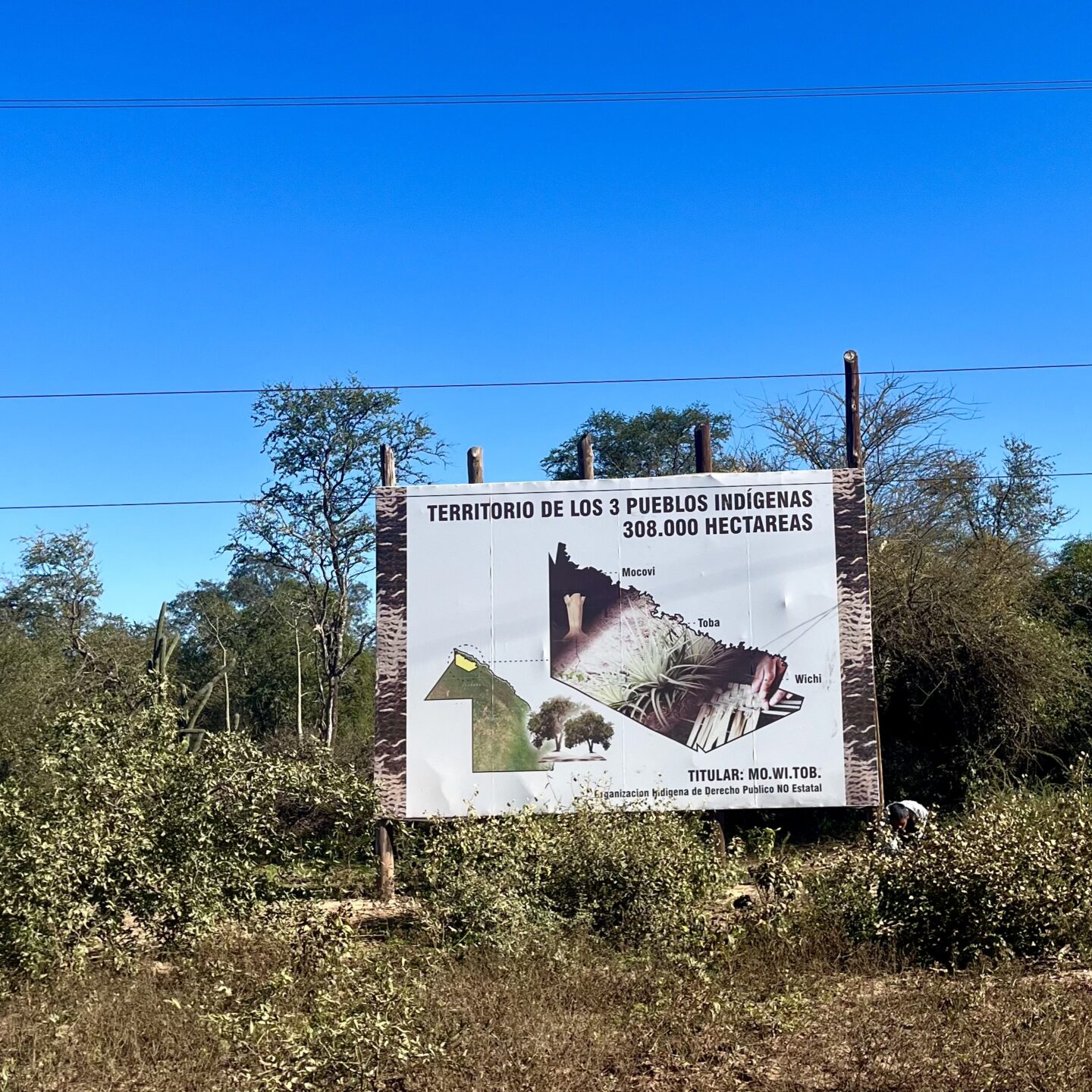
International credibility at risk
Under Milei, the “dismantling” of the state apparatus has “encouraged institutional permissiveness over deforestation”, said Ana di Pangracio, interim executive director of FARN.
“The failure to comply with international commitments and national laws affects Argentina’s international credibility, hinders access to climate and biodiversity financing, and affects the conditions for entering international markets that are of interest to Argentina,” Di Pangracio added.
Last year, Milei attempted to modify the country’s Forest Law as part of a broader reform bill, seeking to loosen the legislation’s controls on deforestation on certain land, but eventually dropped the plan in order to garner sufficient support from opposition lawmakers to pass the wider measures.
Explainer: Brazil’s “right answer” to forest finance turns to markets to keep rainforest standing
“Axe-breaker” tree no match for chainsaws
The biggest driver of deforestation in northern Argentina is agriculture: mainly soy farming and cattle grazing, which has been pushed northwards as the best arable land is used up further south.
Decades of “systematic clearing” have taken a heavy toll on Chaco’s emblematic quebracho tree – meaning axe-breaker due to its hard wood, said Collet, the park ranger. Along with its wood, the tree is exploited for its tannins, which are used for curing leather products such as luxury handbags and car upholstery.
Despite the 2024 deforestation ban, there are signs that trees continue to be cut down in Chaco.
During a July visit to the town of Juan José Castelli, which lies just outside the El Impenetrable national park, a large truck loaded with tree trunks was parked up in front of the police station – apparently confiscated along with its load.
In May, Governor Leandro Zdero hailed the arrival of new satellite-equipped trucks, which he said had helped forest service officials halt an illegal deforestation incident.
But environmental activists told Climate Home that for the most part, those responsible for deforestation, including large-scale landowners, do so with impunity in a province plagued by corruption.
Struggle to protect Indigenous land
For Chaco’s forest defenders, who include members of Indigenous communities, there have been some small victories.
In August, the provincial government partially vetoed a law that had been heavily criticised in April for lessening fines and allowing the use of illegally deforested timber for profit, creating an incentive for illicit tree-cutting.
Bigger battles continue, however.
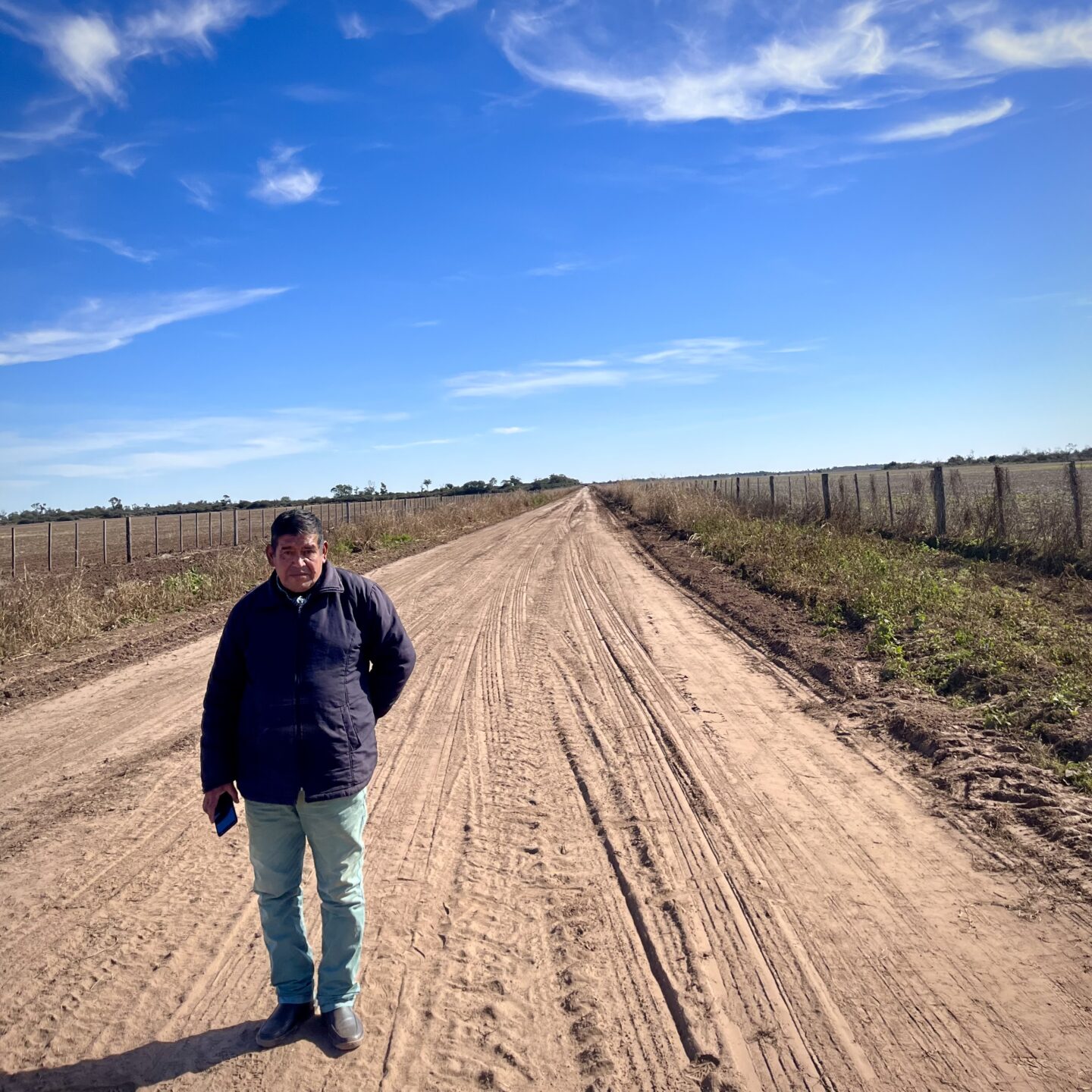
Óscar Villalba, a member of the Moqoit Indigenous community, has been fighting in the courts to secure his people’s land rights since 2012, when the 308,000 hectares (761,000 acres) of the forested Reserva Grande in western Chaco were recognised as Indigenous land jointly belonging to the Moqoit, Wichí and Toba – or Qom – communities.
Despite the recognition by a provincial Indigenous rights body, governors have twice blocked court rulings that supported the Indigenous communities’ exclusive rights to live on and work the land, Villalba said, adding that in the meantime, loggers have had free rein to encroach on the land and cut down trees.
The provincial government did not reply to requests for comment.
“For many years we have been travelling, walking, denouncing, demanding that the government grant us hearings,” Villalba said, struggling to hold back tears as he stood by the side of a dusty road near the reserve. “There is no response. But they are cutting down trees to their heart’s content, day and night.”
The post Milei’s budget cuts fuel deforestation fears in Argentina’s Chaco appeared first on Climate Home News.
Milei’s budget cuts fuel deforestation fears in Argentina’s Chaco
-
Climate Change2 years ago
Spanish-language misinformation on renewable energy spreads online, report shows
-
Climate Change Videos2 years ago
The toxic gas flares fuelling Nigeria’s climate change – BBC News
-
Climate Change2 months ago
Guest post: Why China is still building new coal – and when it might stop
-

 Greenhouse Gases1 year ago
Greenhouse Gases1 year ago嘉宾来稿:满足中国增长的用电需求 光伏加储能“比新建煤电更实惠”
-

 Climate Change1 year ago
Climate Change1 year ago嘉宾来稿:满足中国增长的用电需求 光伏加储能“比新建煤电更实惠”
-
Greenhouse Gases2 months ago
Guest post: Why China is still building new coal – and when it might stop
-

 Carbon Footprint1 year ago
Carbon Footprint1 year agoUS SEC’s Climate Disclosure Rules Spur Renewed Interest in Carbon Credits
-
Renewable Energy3 months ago
US Grid Strain, Possible Allete Sale

